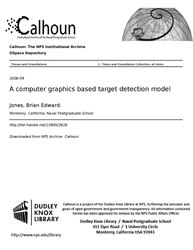File:A computer graphics based target detection model (IA acomputergraphic109452628).pdf

Original file (1,275 × 1,650 pixels, file size: 8.31 MB, MIME type: application/pdf, 106 pages)
Captions
Captions
Summary[edit]
| A computer graphics based target detection model
( |
||
|---|---|---|
| Author |
Jones, Brian Edward. |
|
| Title |
A computer graphics based target detection model |
|
| Publisher |
Monterey, California. Naval Postgraduate School |
|
| Description |
Modeling of visual perception for computer-generated forces and intelligent software agents is usually fairly feeble in computer games and military simulations. Most of the time, tricks or shortcuts are employed in the perceptual model. Under certain conditions, these shortcuts cause unrealistic behavior and detract from military training and user immersion into the simulated environment. Many computer games and simulations trace a ray between the target and observer to determine if the observer can see the target. More complex models are sometime used in military simulations. One of these models used in Army simulations is the ACQUIRE model. This model still may produce debatable results. The ACQUIRE visual perception model uses a single value for the targetâ s contrast with its background. This can cause unrealistic results in certain conditions, allowing computer-generated forces to see targets that should not be seen and not see targets that should. Testing these more complex models needs to be completed to determine the conditions under which the model gives questionable results. Testing ACQUIRE against human subjects helped determine when ACQUIRE behaves reasonably. The study consisted of multiple scenes with a target in many positions, multiple postures, and many different lighting and fog conditions. Now that testing and analysis is complete, modifications can be made to the visual perception model allowing it to give better results in more varied conditions, such as: low light, excessive fog conditions, and partially hidden targets. Subjects: Software engineering; Virtual reality; Computer graphics; Artificial intelligence |
|
| Language | English | |
| Publication date | September 2006 | |
| Current location |
IA Collections: navalpostgraduateschoollibrary; fedlink |
|
| Accession number |
acomputergraphic109452628 |
|
| Source | ||
| Permission (Reusing this file) |
Approved for public release, distribution unlimited | |
Licensing[edit]
| Public domainPublic domainfalsefalse |
This work is in the public domain in the United States because it is a work prepared by an officer or employee of the United States Government as part of that person’s official duties under the terms of Title 17, Chapter 1, Section 105 of the US Code.
Note: This only applies to original works of the Federal Government and not to the work of any individual U.S. state, territory, commonwealth, county, municipality, or any other subdivision. This template also does not apply to postage stamp designs published by the United States Postal Service since 1978. (See § 313.6(C)(1) of Compendium of U.S. Copyright Office Practices). It also does not apply to certain US coins; see The US Mint Terms of Use.
|
 | |
| This file has been identified as being free of known restrictions under copyright law, including all related and neighboring rights. | ||
https://creativecommons.org/publicdomain/mark/1.0/PDMCreative Commons Public Domain Mark 1.0falsefalse
File history
Click on a date/time to view the file as it appeared at that time.
| Date/Time | Thumbnail | Dimensions | User | Comment | |
|---|---|---|---|---|---|
| current | 22:02, 13 July 2020 |  | 1,275 × 1,650, 106 pages (8.31 MB) | Fæ (talk | contribs) | FEDLINK - United States Federal Collection acomputergraphic109452628 (User talk:Fæ/IA books#Fork8) (batch 1993-2020 #5270) |
You cannot overwrite this file.
File usage on Commons
The following page uses this file:
Metadata
This file contains additional information such as Exif metadata which may have been added by the digital camera, scanner, or software program used to create or digitize it. If the file has been modified from its original state, some details such as the timestamp may not fully reflect those of the original file. The timestamp is only as accurate as the clock in the camera, and it may be completely wrong.
| Short title |
|
|---|---|
| Author | jchiggin |
| Software used | PScript5.dll Version 5.2.2 |
| File change date and time | 08:20, 29 September 2006 |
| Date and time of digitizing | 05:36, 29 September 2006 |
| Date metadata was last modified | 08:20, 29 September 2006 |
| Conversion program | Acrobat Distiller 6.0.1 (Windows) |
| Encrypted | no |
| Page size | 612 x 792 pts (letter) |
| Version of PDF format | 1.4 |

